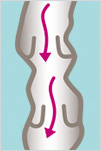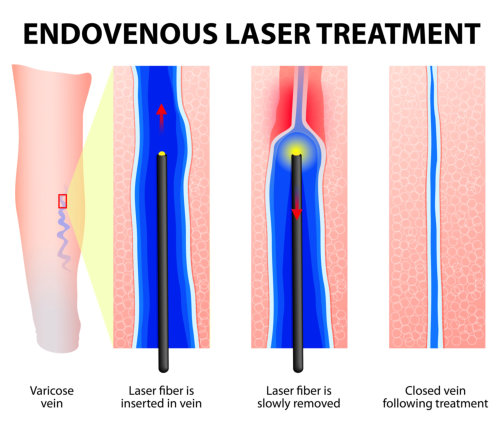Endovenous Laser Treatment for Varicose Veins
Laser Therapy for Varicose Veins
What are varicose veins?
Varicose veins are the large, “rope-like” veins which are often one-quarter inch or larger in diameter.
What causes varicose veins?
Varicose veins occur when veins are not properly returning blood from the lower leg to the heart. All veins have valves that open to allow the flow of blood to the heart and close to prevent back flow (otherwise know as “reflux”) of blood to the foot. When valves fail to function properly, blood leaks through and flows down the leg in the wrong direction. The blood overfills and distends the superficial veins under the skin, resulting in the bulging seen in varicose veins.
How common are varicose veins?
Approximately half of the population has some form of venous disease, and varicose veins affect about one out of two people age 50 and older, and 15-25% of all adults.
How does endovenous laser therapy work?
Previously, treatment of painful, swollen varicose veins required a surgical procedure called vein stripping, where the vein was completely removed from the leg. More recently, endovenous laser therapy has been developed to treat chronic venous insufficiency by delivering laser energy through a small puncture in the leg to close the diseased vein.
With endovenous laser therapy, no surgery is required, and the entire procedure can be performed in less than one hour in your physician’s office.
During the procedure, you are awake and your leg is anesthetized. A thin laser fiber is inserted into the greater saphenous vein in your thigh. Your physician then will deliver laser energy through the fiber and into the vein, causing the vein to close.
Why is the laser fiber placed in the thigh, when the varicose veins are located below the knee?
Bulging varicose veins in the lower leg usually are caused by a faulty valve located higher in the leg that can’t be seen at the surface. The endovenous laser therapy treats the source of the problem, which then causes the varicose vein in the lower leg to shrink and disappear.
Is the loss of the vein a problem?
No. Because there are many veins in the leg, the blood that would have flowed through the closed vein simply flows through other healthy veins after the laser therapy.
Is endovenous laser therapy painful?
Although individual responses vary, most people report little to no pain associated with endovenous laser therapy. Often the only sensation is felt during the delivery of anesthetic to the leg. After the procedure you may feel some tenderness, tingling. Itching of tightness in the treated leg, which should disappear within a month.
How successful is endovenous laser therapy?
Clinical results have been published which document the success of endovenous laser treatment. Like any medical treatment, however, endovenous laser therapy has certain risks which your physician will explain to you as they apply to your individual case.
What should I do after the procedure?
After endovenous laser therapy, a gauze pad and tape will be placed over the puncture site and a compression stocking or compression bandage will be placed on your leg. You are encouraged to immediately walk following the procedure and resume normal activities. However, during the two weeks following your procedure you should avoid swimming, vigorous gym workouts, hot baths or excessive sun. Your physician will provide customized instructions for you to observe following your endovenous laser therapy, including how long to wear a compression stocking. If you have any questions, ask your physician.
What should I expect after the procedure?
You should expect to see some bruising along the treatment site as the vein disappears, which is normal and should gradually go away within a month. You also may feel some tenderness, tingling, itching or tightness in your treated leg during the two weeks following the procedure. If you experience significant pain, or have bleeding of the treated leg, contact your physician promptly,
How can I get more information on varicose veins?
More information on the causes and treatments of varicose veins can be found at www.veins.nu As always, for information on your specific condition, ask your physician.
This procedure improves the veins appearance, reduces the heaviness,achiness, swelling and itching in the legs related to venous insufficiency and prevents the formation of Venous ulcers in the legs.
Please Contact us for a consultation.
We accept most insurance plans. (702) 838-0444




